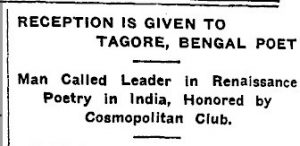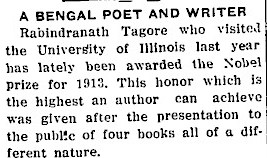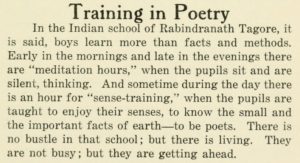On this date in 1861, just a few years ahead of the University of Illinois, Mr. Rabindranath Tagore was born. Although Mr. Tagore’s life is well-known, his time and his son’s studies at the University of Illinois might be less known. In fact, his writings would be continued to be read, discussed, and performed across campus and around town long after his first visit.
Read on to learn more about Rabindranath Tagore at the University of Illinois!
1912-1913
Over one century ago, from late fall 1912 through winter 1913, on 909 West Nevada Street, the Bengali polymath (and soon to be 1913 Nobel Prize for Literature recipient) Mr. Rabindranath Tagore read selections of poetry and spoke to a local group later known as the Tagore Circle. While Mr. Tagore was not an alumni nor was he a member of the University, his son Rathindranath was an alumni, who later brought his wife, Pratima, and his father, Rabindranath, to campus just three years after graduation.
- A 1910 Illio profile photo of Mr. Rathindranath Tagore, found in Record Series 41/8/805.
Mr. Rathindranath Tagore, (B.S. Agriculture, 1909) of Calcutta, completed his studies in Agriculture. [1] After graduation and returning to his family home, Mr. Tagore became a recognized expert of landed estates, and he became Director of the Brahma-Vidyalaya Institute and a Member of the Literary Society of Bengal.
As a student, Mr. Tagore was involved in student life. In Cosmopolitan Club (Record Series 41/64/8), he had been a treasurer, a vice-president, and president. In 1907, with Mr. Santosh Chandra Majumdar, (B.S. Agriculture, 1909), he co-organized a cultural display of South Asian goods at a Unitarian Church bazaar. While he was a student, some of Rathindranath Tagore’s local talks included, “England and India” for Cosmopolitan Club (December 1907), “Rice Cultivation in India” for Agricultural Club (March 1908), and even “Literature of India” for Agricultural Club (March 1909).
- A 1912 Daily Illini announcement for Mr. Tagore’s 1912 arrival, found in Record Series 41/8/802.
During the Fall 1912 term, Mr. Rathindranath Tagore returned to complete graduate coursework in science, The Daily Illini reported, and he brought his wife and his father with him. While Rathindranath stayed with Spanish Professor and Foreign Student Advisor Arthur R. Seymour and his wife, the writer Mayce F. Seymour, while his father stayed with Electrical Engineering Professor Morgan Brooks, The Daily Illini reported. [2][3][4]
While in town, Mr. Rabindranath Tagore gave a series of lectures at the Unitarian Church on Oregon and Mathews (now Unitarian and Universalist Community Center). During the second and third weeks of November, Mr. Tagore gave a four-lecture series on spiritual thought, including The Upanishads (November 17), religion in ancient India (November 23), and Hindu thought as well as the problem of evil (November 27).
- A 1912 Daily Illini announcement for a student reception for Mr. Tagore and his wife, found in Record Series 41/8/802.
Some local students enthusiastically met with Mr. Tagore. Within weeks of his arrival, on December 10, at the Cosmopolitan Club House, a reception was hosted for him by the Hindu Student Association. Another week later, the December issue (Volume IV, Number 3) of the student-produced Illinois Magazine (Record Series 15/7/810) included several translated selections of Mr. Tagore’s writing in addition to an introductory essay by Mrs. Seymour.
- A 1913 Daily Illini article announcing a talk by Mr. Tagore, found in Record Series 41/8/801.
Mr. Tagore remained in town until at least March, as evidenced in an address which he gave to the Cosmopolitan Club (Records Series 41/64/8). The talk was titled “The Ideals of the East and West”, according Daily Illini reporting.
- A 1912 Illinois Magazine article about Mr. Tagore found in Record Series 15/7/810.
Concurrently, a great variety of Mr. Tagore’s works had been published, including Gitanjali, as Professor Seymour wrote in a Letter to the Editor in The Daily Illini, in May (and advertised in December). Just months later, during November 1913, Mr. Tagore was awarded the Nobel Prize for Literature.
- A 1913 Daily Illini announcement for Mr. Tagore’s 1913 Nobel Prize for Literature, found in Record Series 41/8/802.
Local Readings and Recollections
- A 1914 Daily Illini article announcing a talk about Mr. Tagore, found in Record Series 41/8/801.
After Mr. Tagore left town, his writings and his ideas would continue to be discussed locally. In 1914, his writing was a featured topic in the English faculty’s new Tuesday Night lectures on contemporary literature. That February, English Professor C. V. Boyer read selections and led a discussion. In fact, it was later reported that Dr. Boyer had attended Mr. Tagore’s readings and he later recalled fondly the pleasure of hearing a writer discuss their own work.
- A 1914 Daily Illini article announcing a local birthday celebration of Mr. Tagore’s life, found in Record Series 41/8/801.
Later in May, for a Cosmopolitan Club celebration of Mr. Tagore’s birthday, Professor Boyer was invited to read and speak more, supported by two students who studied at Mr. Tagore’s school before coming to Illinois, at Morrow Hall. Also in May, Illinois German Professor Otto E. Lessing’s account of meeting Mr. Tagore was even cited in an essay in the national Cosmopolitan Club publication Cosmopolitan Student.
- A 1914 Illinois Magazine article about pedagogy at Mr. Tagore’s school, found in Record Series 15/7/810.
In June 1914, the Illinois Magazine (Volume V, Number 8) included a brief review of pedagogy at Mr. Tagore’s famous school, the Patha Bhavana, in Santiniketan, Bolpur, West Bengal, India. In fact, multiple Illini were students at Patha Bhavana, before coming to Illinois. Some early students included Mr. Somendra Chandra Barman, (A.B. in Liberal Arts and Sciences, 1915), N. K. Deiral, and Mr. Bankim Chandra Ray, (B.S. Electrical Engineering, 1915).
Outside of classrooms, student literary societies and the off campus communities continued to discuss Mr. Tagore’s writings. In December 1914, the Alethenai Literary Society (Record Series 41/75/2) hosted graduate student Olive E. Paine (B.S. General Science, 1914; M.A. Education, 1915), of North Woodstock, Connecticut, who led multiple interpretative readings. In February 1915, the Alethenai Literary Society then hosted an evening program which included the talk “Life of Tagore” by Mildred E. Griffith, (A.B. 1915) and readings of Sir Tagore’s writings by Maud I. Marks (A.B. 1918). In July 1915, at the Unitarian Church, Reverend A. R. Vail gave a sermon about the religions of India with an emphasis on the poetry of Sir Tagore.
In fact, for years, off campus, Reverend Vail continued to give a variety of sermons and analytical talks about Sir Tagore’s ideas and writings, including:
- A comparative discussion of both Tagore’s work in India as well as the Baha’i faith in Iran (October 1926);
- “Tagore’s Solution of the Problem of Evil” (November 1916);
- “Does Environment or Heredity Make the Soul? How Mr. Tagore Answers This Question” (November 1916);
- “How the Great Poet Mr. Tagore Would Apply the Principles of Christ to the World of Today–A Study of His Recent Lectures in Urbana and Their Surprising Conclusions (January 1917);
- “The Spiritual Dramas of Rabindranath Tagore (July 1917);
- “The Hindu Thought of God and the Origins of the Soul–The Contribution of Rabindranath Tagore (October 1917); and
- “The Great Awakening in Asia–The Old Order and the New as Reflected in the Dramas of Sir Rabindranath Tagore” (February 1918).
While Sir Tagore had left town for years, his ideas and his presence would be kept alive for many more. To the pleasant surprise of many Illini, it would not be too long before a second campus visit would occur, during another winter in Champaign-Urbana.
References
[] As always, a special thank you to all students and staff whose tireless work for student life and publications (many of which are available at the University Archives) help preserve the memories of Illini everywhere.
[] A comprehensive guide to the University Library’s holdings pertaining to Rabindranath Tagore can be found along with many other helpful LibGuides.
[1] “Rathindra Nath Tagore”, The Semi-Centennial Alumni Record of the University of Illinois, Edited by Franklin W. Scott, page 363. For personal remarks about Rathindranath Tagore’s experiences in Illinois, please see: On the Edges of Time, by Rathindranath Tagore. Calcutta: Orient Longmans. 1958. For a recent English and Bengali study of Mr. Tagore’s life, please see: Rathindranath Tagore: The Unsung Hero, Edited by Tapati Mukhopadhyay and Amrit Sen. Santiniketan. Rabindra-Bhavana, Visva-Bharat. 2013.
[2] Professor Morgan Brooks’ papers can be found at Swarthmore College. Please see: “Brooks Family Papers, 1790-1992“; Professor Arthur and Mayce Seymour’s papers can be found at Florida State University. Please see: “Arthur and Mayce Seymour Collection“. Also see: “The Golden Time”, by Mayce Seymour, in Visva-Bharati Quarterly. 1959. For a collection of correspondence between the Seymours and Rabindranath Tagore, please see: A Home In Urbana: Correspondence Between The Tagores And The Seymours. Edited by Supriya Roy. Kolkata: Patralekha. 2011.
[3] For personal remarks about Rabindranath Tagore’s experiences in the U.S., the University of Illinois, and Urbana-Champaign, can be read in publications like: Selected Letters Of Rabindranath Tagore. Edited by Krishna Dutta and Andrew Robinson. Cambridge: Cambridge University Press, 1997. For a bibliographic survey of his U.S. experiences documented in U.S. archives, please see: “Finding Rabindranath Tagore in the Holdings of the National Archives“, by Tisha Mondal and Judy Luis-Watson, in Education Updates. National Archives and Records Administration. Online.
[4] For even further reading, please see: “Rabindranath Tagore in Urbana”, by Harold Hurwitz, in Indian Literature. 1961; “Tagore and the Urbana Unitarians 1906-1921”, by Ingrid Kallick, in Rabindranath Tagore for the 21st Century. Urbana: Tagore Center. 1992.; and “Cosmopolitan Club, Tagores, and UIUC: A Brief History of 100 Years” by Anil K. Bera. Self published. 2006.










